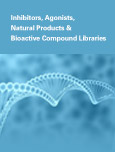| Cat. No. |
Product Name |
Information |
| PC-61949 |
Mefuparib hydrochloride
PARP inhibitor
|
Mefuparib hydrochloride (CVL218) is a potent, highly selective, competitive PARP1/2 inhibitor with IC50 of 3.2/1.9 nM, respectively. |
| PC-61158 |
PARP14 inhibitor H10
PARP14 inhibitor
|
PARP14 inhibitor H10 (H10) is a potent, selective, cell-active PARP14 inhibitor with IC50 of 490 nM, with good selectivity over other PARPs (24-fold and 18-fold over PARP1 and TNKS1, respectively). |
| PC-60483 |
Pamiparib
PARP1/2 inhibitor
|
Pamiparib (BGB-290, BGB290) is a highly potent, selective and brain penetrant PARP1/2 inhibitor with IC50 of 0.9 nM and 0.5 nM for PARP1 and PARP2, respectively. |
| PC-60367 |
TNKS-IN-41
Tankyrase inhibitor
|
TNKS-IN-41 is a highly potent and selective tankyrase inhibitor with pIC50 of 8.5 and 8.1 for TNKS1 and TNKS2, respectively. |
| PC-60021 |
GeA-69
PARP14 inhibitor
|
GeA-69 (GeA69) is a potent, selective, allosteric, cell-active PARP14 macrodomain 2 (MD2) inhibitor with Kd of 0.86 uM in ITC assays. |
| PC-42680 |
Rucaparib
PARP inhibitor
|
Rucaparib (AG014699, PF-01367338) is a potent inhibitor of PARP with Ki of 1.4 nM for PARP1 in a cell-free assay, also showing binding affinity to eight other PARP domains. |
| PC-42679 |
Rucaparib phosphate
PARP inhibitor
|
Rucaparib (AG014699, PF 01367338) phosphate is an inhibitor of PARP with Ki of 1.4 nM for PARP1 in a cell-free assay, also showing binding affinity to eight other PARP domains. |
| PC-42410 |
Olaparib
PARP inhibitor
|
Olaparib (AZD2281, KU-0059436) is a potent, specific, and orally active PARP inhibitor with IC50 of 5 and 1 nM for PARP1 and PARP2, respectively. |
| PC-45620 |
MN-64
TNKS1 inhibitor
|
MN-64 is a potent and selective inhibitor of Tankyrase 1 (TNKS1) with IC50 of 6 nM. |
| PC-45571 |
NMS-P118
PARP1 inhibitor
|
NMS-P118 is a potent and highly selective PARP-1 inhibitor with Kd of 9 nM; shows 150-fold selectivity for PARP-1 over PARP-2. |
| PC-42269 |
BGP-15
PARP inhibitor, Hsp72 modulator
|
BGP-15 is a PARP inhibitor and an inducer of HSF-1/HSP72 (cotreatment with heat) in vtiro, has no effect on HSP90 levels. |
| PC-45086 |
WIKI4
TNKS2 inhibitor, Wnt/β-catenin inhibitor
|
WIKI4 is a novel small molecule inhibitor of the Wnt/β-catenin pathway by inhibiting the enzymatic activity of TNKS2. |













